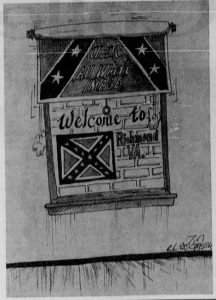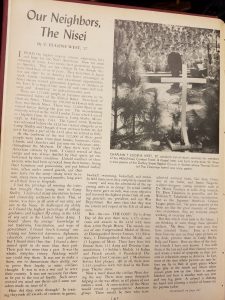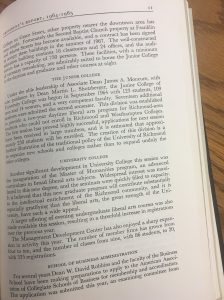by Katie Brennan
Kaitlin Brennan is a senior from Fairfield, Connecticut majoring in PPEL and Rhetoric & Communication Studies, contributing to the Race & Racism Project through the Fall 2017 RHCS 412 Digital Memory & the Archive course. The Race & Racism project has helped her think about race not only on the University’s campus but in the city of Richmond in general. She has become especially interested in how the University has talked about race and gender equality to the public, including to its students.
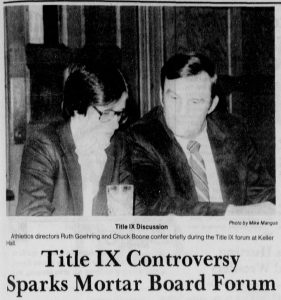
In this post, I will focus on the December 3, 1981 article titled “Title IX Controversy Sparks Mortar Board Forum,” found in the University of Richmond newspaper, The Collegian. Written by staff writer Pat Everett, the article described a Mortar Board sponsored forum held to discuss gender equality in University athletics. Everett indicated that, as a result of a pending court decision on whether the University’s athletic programs violated the sex equality law, students received few concrete answers from administrators. William Leftwich, Vice President for student affairs and Title IX coordinator, as well as Elaine Yeates, chairman of the Board of Trustees’ Athletic Committee, hesitated to answer questions from female athletes. Additionally, the athletic director, Chuck Boone, and the women’s athletic director, Ruth Goehring, gave few explicit answers due to additional pending litigation between the National Collegiate Athletic Association (NCAA) and Association of Intercollegiate Athletics for Women.
Despite this, administrators still maintained that progress had been made in the women’s athletic department since 1979, citing examples such as an increase in scholarships available to women and athletic success of female teams, particularly the women’s basketball team. Female athletes at the forum pressed administrators on issues of inequalities in athletic budgets, treatment of athletes with respect to travel, hotels, transportation, restaurants, and recruiting, as well as the number of available scholarships. Peg Hogan, coach of the women’s swim team, suggested that everyday issues, such as lack of heating in the Keller Hall locker room and availability of practice times, depicted obvious gender inequalities. However, Goering suggested that women were not always worse off than men and, in some ways, might even have been better off: “We have a law that says we must be treated fairly, the men don’t.”
Read more
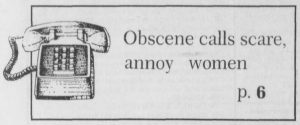 On February 23, 1984, Collegian staff writer Ginny Yoder broke a story on sexual harassment plaguing the University of Richmond: “Obscene: Women get phone calls.” Residents in the Westhampton College dorms and University Forest Apartments had begun to receive obscene phone calls from unidentified callers. An epidemic of sexual harassment began spread from phone to phone around Westhampton College.
On February 23, 1984, Collegian staff writer Ginny Yoder broke a story on sexual harassment plaguing the University of Richmond: “Obscene: Women get phone calls.” Residents in the Westhampton College dorms and University Forest Apartments had begun to receive obscene phone calls from unidentified callers. An epidemic of sexual harassment began spread from phone to phone around Westhampton College.
